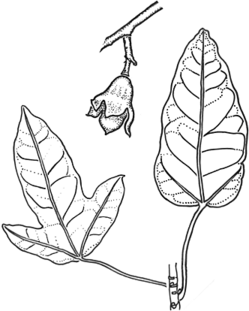Common name: flame tree, Illawarra flame tree
Brachychiton acerifolius (A.Cunn. ex G.Don) F.Muell. APNI* Synonyms: Sterculia acerifolia A.Cunn. ex G.Don APNI*

Description: Tree to 35 m, deciduous, flowers produced in spring on leafless branches.
Adult foliage usually entire or shallowly 3-lobed, juvenile leaves often deeply 5-lobed; lamina rhombic to ovate, usually 10–30 cm long, entire or widely 3–5-lobed, glabrous, apex short-acuminate; petiole mostly 10–20 cm long.
Flowers 10–20 mm long, bright coral-red. Carpels glabrous.
Follicle glabrous, c. 10 cm long, on stalks 6–8 cm long; seed endocarp tomentose.
Distribution and occurrence: Widespread in subtropical rainforest on the coast to the escarpment, north from the Shoalhaven R. Cultivated in gardens and occasionally naturalised.
NSW subdivisions: NC, CC, NT, ?CWS, *LHI
Other Australian states: Qld
In NE N.S.W. hybrids between this species and B. discolor have been found. The leaves are large with lamina c. 11–20 cm long and wide, glabrous or almost so, 3–5-lobed, the lobes wide-triangular; branchlets pubescent.
Text by G. J. Harden (1990); edited KL Wilson (June 2010)
Taxon concept: G.P. Guymer (1988)
APNI* Provides a link to the Australian Plant Name Index (hosted by the Australian National Botanic Gardens) for comprehensive bibliographic data
***The AVH map option provides a detailed interactive Australia wide distribution map drawn from collections held by all major Australian herbaria participating in the Australian Virtual Herbarium project.
|


